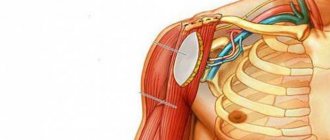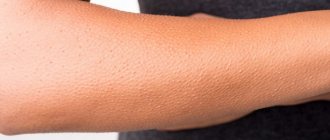Some people often wake up because their arms and legs go numb in their sleep. This is a very common phenomenon consisting of loss of sensation in the limbs, called paresthesia.
The range of sensations associated with this disorder is very diverse, although it is individual in nature. In most cases, painful sensations of an aching nature predominate, but cases of “tingling” in the limbs are also common.
Movement of numb limbs causes severe discomfort; in addition, movement often leads to complete numbness of the limb and sometimes to loss of control over it. After some time, about several tens of minutes, the numbness goes away.
Causes of numbness not related to pathologies
When your arms and legs go numb during sleep, do not rush to assume the presence of chronic pathologies - often this condition occurs under the influence of some external or internal factors that cause the symptom.
These causes of numbness in the arms and legs at night include:
- Sleeping position is the first thing to consider when limbs begin to go numb. Please note that if the knees are too bent and the arms are compressed by the weight of the body, this can lead to compression of blood vessels and nerves, causing numbness;
- Clothes - often tight pajamas are the reason that in the morning your arms and legs become weak. When clothes tighten during the day, we can control this process, but at night it is more difficult to notice. As a result, after a few hours you wake up with “cotton” arms and legs;
- Mattress and pillow – sometimes your legs go numb during sleep due to the surface being too soft or hard to sleep on. Don't forget about your hands - your head should rise a few centimeters above the level of the mattress. Otherwise, the vessels and nerve roots going to the hands and forearms are compressed;
- Bad habits - many patients suffering from alcohol and nicotine addiction note tingling hands and feet in the morning. Here the cause is poisoning at the cellular level, due to which the blood supply and trophism of the limbs are disrupted;
- Nutrition - lack of vitamins and necessary building materials for tissues is a common cause of numbness. To prevent its development, it is recommended to follow a diet and lead a healthy lifestyle.
Numbness often occurs during pregnancy in women - here the reasons may be increased stress on the legs, changes in posture and displacement of internal organs due to the growth of the fetus. In such situations, an uncomfortable position, clothing or a hard mattress puts more pressure on the nerves, causing loss of sensitivity. Don’t forget about hormonal imbalances and vitamin deficiencies during this period.
Causes of numbness in hands and feet
Traditional recipes against seizures
Traditional medicine is more often used at the initial stage of the disease, as additional therapy or prevention of hand cramps at night.
Honey compresses
Honey compresses, which are performed in different versions, will help you quickly cope with pain, numbness and cramps in the hands at night:
- Smear your hands with honey and wrap them in cotton cloth, leaving them overnight.
- Candied honey can be used in the form of cakes. To do this, melt the honey a little until it becomes plate-shaped. Form a cake and apply to a specific area of the body. Cover with polyethylene and wrap with cloth. Leave overnight.
- Lubricate the area where pain is noted with honey and apply a previously mashed cabbage leaf. Wrap up.
Due to the harmlessness and naturalness of the components, such compresses can be used even by small children and pregnant women. Honey is also a preventative against seizures.
Alcohol-based rubbing reduces seizures
For hand cramps at night, rubbing with alcohol is effective.
Lilac rub can be prepared at home. Pour lilac flowers into a half-liter jar and compact well. Pour alcohol (dilute a little with water to 40 degrees) and let it brew for two weeks. Rubbing your hands in the morning and evening.
Another recipe: 1 liter of water, 1 tbsp salt, 50 ml. ammonia and 10 ml of camphor alcohol. Mix all components until the salt is completely dissolved. Rub your wrist and fingers before going to bed. This will help reduce hand cramps.
Mustard oil against cramps
Mustard powder and oil have long been known for their warming properties. Therefore, it is perfect for rubbing hands during cramps. Mustard ointment can be prepared at home. To prepare it you need 2 tsp. mustard powder, as well as Vaseline or olive oil. Mix everything well and lubricate areas of the skin during an attack of cramps.
You can prevent hand cramps from occurring at night by following the recommended preventive measures. Namely, minimize the harmful effects of bad habits on the body, move more. If you spend a long time at the computer, do hand exercises every day.
When pathology is to blame
Sometimes the cause of loss of sensitivity can be a chronic disease. In this case, numbness is only a symptom that occurs against the background of a disturbance in the physiology of the body. The list of diseases is as follows:
- Intervertebral hernias, curvatures, osteochondrosis;
- Sciatica;
- Arthritis of various types;
- Vascular diseases, varicose veins, atherosclerosis;
- Stroke and cerebral sclerosis;
- Injuries;
- Tumors.
Attention!
With these pathologies, a characteristic clinical picture is observed in the form of many syndromes indicating damage to other organs.
Development of the disease
An unpleasant feeling of numbness is also observed with serious health problems. Symptoms appear in the following diseases:
- osteochondrosis in advanced form, when an intervertebral hernia has formed;
- neuralgia with damage to the nerve plexus in the shoulder area;
- injuries to the hands, knees, wrist, shoulder, shoulder blades, or neck;
- stroke or a pre-existing condition;
- high blood pressure;
- vascular pathologies (Raynaud's disease, Buerger's disease or atherosclerosis);
- migraine;
- systemic collagenoses;
- cancer.
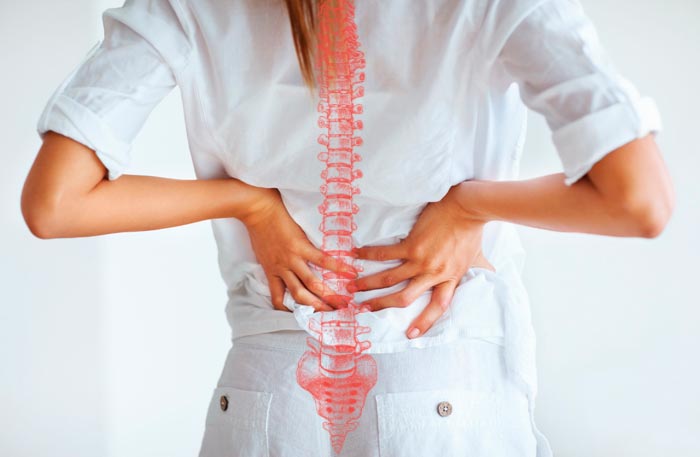
This is not the entire list of pathologies that can cause the legs or upper limbs to go numb during sleep. There are significantly more diseases accompanied by a feeling of heaviness and numbness. It is extremely important to identify them immediately in order to select the appropriate treatment tactics.
Associated symptoms
Numbness of the hands and feet is a systemic disorder and is therefore accompanied by a number of characteristic symptoms. Against the background of a lack of innervation and blood circulation, cell nutrition is disrupted, which leads to a disorder of local physiology.
The symptoms are as follows:
- Pain – occurs with prolonged numbness or complications. The cause is lack of blood flow. Usually the pain is aching, bursting or burning;
- A decrease in pulse indicates compression of the arterial vessels. Marked on the forearm, in the area of the popliteal fossa;
- Paresthesia is an unpleasant sensation in the palms and soles. According to the descriptions of patients, they resemble short-term numbness for a few seconds of a migrating nature.
Carpal tunnel syndrome
Carpal or tunnel syndrome is an occupational disease of those specialists who constantly make the same monotonous movements with their fingers or hands for many years:
- pianists;
- typists on keyboards and typewriters;
- cashiers;
- drivers; builders;
- athletes.
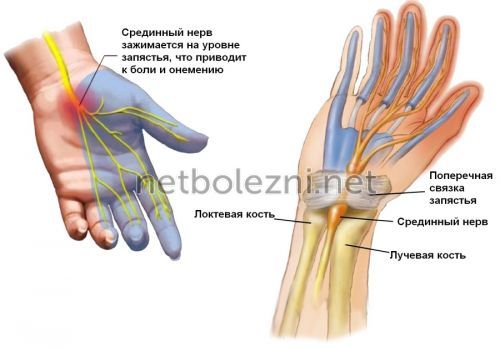
The first symptom of the disease is transient short-term numbness of the fingers, tingling or burning. The progressive disease is manifested by aches and pains in the hands and fingers.
The pain may spread to the elbow joints. At night these pains make it difficult to fall asleep. Relief comes from rubbing and rotating the hands. The cause of this pain is pinching or compression of the nerve in the median canal of the wrist. Destruction of the canal itself from mechanical stress, trauma, failure of metabolic and hormonal processes in the body (diabetes mellitus, arthritis, pregnancy) leads to damage to the median nerve.
Prevention of the disease (comfortable workplace, hand exercises during work) will help avoid its development.
The neurologist, after conducting an examination (Tinel and Phalen tests, ultrasound or MRI), will choose the most appropriate treatment: a conservative method or surgical intervention. Sometimes, with such a disease, a person is forced to change his profession and occupation.
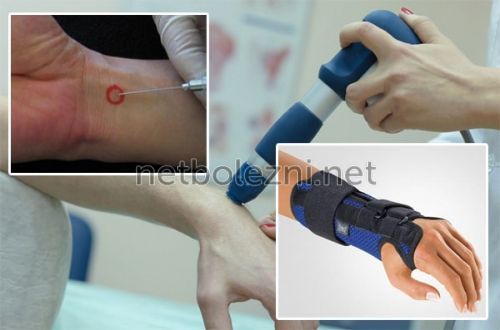
Diagnosis of numbness in hands and feet
To find out the cause of numbness, it is recommended to consult a doctor - the doctor will listen to your complaints and conduct an examination. The first specialist is a general practitioner who will refer you to a neurologist if nerve damage is suspected. If the doctor suspects other diseases that are causing the numbness, a consultation with a phlebologist, rheumatologist, orthopedist or surgeon, or oncologist may be prescribed.
The following methods will help confirm the presence of the underlying disease:
- X-ray;
- CT scan;
- MRI (magnetic resonance imaging) or ultrasound (ultrasound);
- If necessary, blood tests to detect inflammation.
After the examination, a final diagnosis is made and treatment for numbness is prescribed.
Important!
Some methods of therapy are also indicated when a symptom is identified without the presence of pathology. In this case, treatment will be preventive in nature.
Treatment
When a specific cause of numbness in the arms and legs is identified, the necessary therapy is prescribed. Medicines are selected to eliminate a specific disease; other methods are used for almost all diseases, if there are no contraindications.
Drug therapy
Treatment of numbness begins with the selection of medications. Typically used:
- Analgesics (Voltaren, Nise-gel) - indicated in the presence of pain, swelling and inflammation. Prescribed for detecting pinched nerves, arthritis, vascular disease;
- For brain damage and the development of movement disorders, nootropics (Glycine, Piracetam) are indicated;
- Antirheumatic drugs, immunosuppressants - prescribed for rheumatoid arthritis, suspected local oncology;
- Anticoagulants (Heparin and its derivatives) are excellent for circulatory disorders and vascular diseases.
To strengthen the body, vitamins and active supplements can be prescribed, the daily intake of which stabilizes physiological parameters.
Drug therapy for numbness in the arms and legs
Physiotherapy
In order to increase regeneration, increase blood circulation and improve drug absorption, physiotherapeutic methods can be prescribed:
- Electrophoresis;
- Magnetotherapy;
- Laser treatment;
- Warming up;
- UVT or ultrasound treatment.
On a note!
It is important not to miss sessions and to visit the doctor’s office on time. In the absence of the disease in an advanced stage, a course of 10-12 procedures can eliminate the problem of numbness in the legs forever.
Exercise therapy and massage
Don’t forget about therapeutic exercises - exercises are always useful, helping to restore mobility and coordination of movements within a few months. For the warm-up, the following are prescribed:
- Exercise bike;
- Athletics;
- Swimming;
- Special exercises for fingers and toes.
You can supplement your gymnastics courses with a massage, which is carried out 2-3 times a week. In total, both methods promote vasodilation, accelerate blood circulation and improve cellular nutrition.
Alternative medicine for numbness in hands and feet
Some methods in the form of acupuncture, leech treatment and vacuum massage show good results in the treatment of numbness of the limbs. These methods will not eliminate the cause, but will strengthen the body, improve blood counts and the condition of blood vessels. The introduction of thin sterile needles stimulates reflex activity and improves nerve function. It is better to carry out these procedures in specialized salons under the supervision of experienced specialists.
Physiotherapy, exercise therapy, massage and alternative medicine for numbness
How to relieve numbness at home
When it is not possible to visit a doctor, you can resort to temporary therapy at home. This approach will not cure the underlying disease, but will help remove the symptom of minor disorders. The scheme is as follows:
- Before going to bed, take a contrast shower - in most cases, numbness of the arms and legs at night is caused by poor circulation, which improves with a temperature difference during ablution;
- Warming rubs or special products will help speed up blood flow. Warming ointments from the pharmacy (Capsicam, Viprosal) or folk recipes with spices are indicated as medications for numbness.
Important!
If numbness occurs at night, and the hand is already numb, it is recommended to clench and unclench the fingers on the hand or foot. The blood vessels gradually dilate and blood flow to the problem area is restored.
Thermal treatments
You can combine business with pleasure and take a bath with the addition of salt, essential oils or medicinal herbs. This procedure performs several functions at once:
- calms the nervous system;
- improves blood flow;
- has a positive effect on mood;
- relaxes muscles.
The bath should be taken for a limited amount of time (no more than 20 minutes) to avoid dehydration or a sharp increase in blood pressure. Before using additives (salts, oils, etc.), it is recommended to make sure that you do not have allergies.
It is prohibited to carry out thermal procedures under the following conditions:
- heat;
- dehydration;
- hypertension;
- immediately after eating.
USEFUL INFORMATION: Calf muscle cramps at night: causes, treatment, prevention
Unflavored sea salt, lavender, pine needles, Indian onion, and tea tree essential oil are used as additives.






